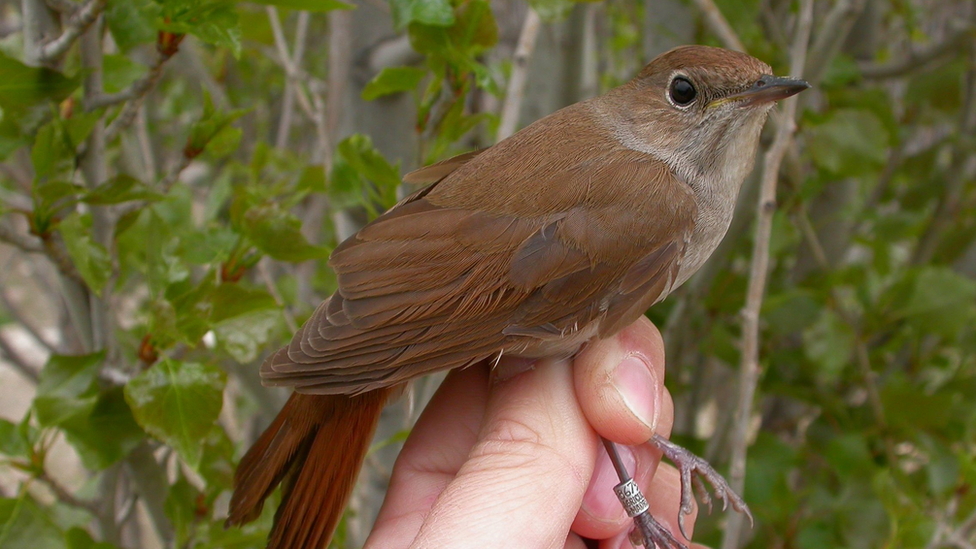Climate change: Warming clips the nightingale's wings
- Published

Rising temperatures may be having a profound physical impact on one of the world's favourite songbirds.
Researchers in Spain that over a 20-year period, nightingales had evolved smaller wingspans.
The scientists say this is linked to a changing climate in the region which has seen the early onset of spring and increased drought.
They are concerned that this could affect the bird's ability to migrate in winter.
Famed for its ability to sing, the nightingale has a very rich repertoire as it is able to produce over 1,000 different sounds, compared to just 340 by skylarks.
Although common in many parts of Europe and Asia, the bird is mainly seen and heard in southern England.
Numbers here have declined markedly over the last half century, down 90%, with multiple factors to blame including deer eating their preferred nesting sites, but also because of a changing climate.
The nightingale spends the winter in sub-Saharan Africa, with the small, brown creature clocking up huge distances during migration.
Wing size is critical to this endeavour.
Now,, researchers say that ability to migrate may be impeded by climate change.
Scientists in Spain have studied 20 years of data on wing shape in two populations of the birds.
They found that the average wing length of the nightingales relative to their body size has decreased.
Rising temperatures may be favouring smaller broods with smaller wings
They believe this is related to changes in temperatures seen in the Mediterranean region.
"Our results show that spring is delayed and the intensity of the summer drought is higher, which means a shorter optimal breeding period for the birds," said Dr Carolina Remacha, from Madrid's Complutense University, who led the study.
"We find the unique possibility that shorter wings are being favoured."
The researchers believe that birds like the nightingale normally adapt to the demands of migration by having longer wings, having a larger clutch size but a shorter lifespan.
However, the changing temperatures are interfering with this and provoking a response from the birds.
Faced with a shorter breeding season, the researchers believe the most successful birds are having smaller families with smaller wings.
They argue that these adaptations are likely to come at a price.
"If these changes are the response to the new environment, then obviously the ones that have been selected, the ones with shorter wings, are the optimal nightingales for the new situation," said co-author Prof Javier Perez-Tris also from Complutense University.
"These are not the best wings for migration, but the shorter wings come in the same package."
The researchers say that the birds are continuing with the same migration patterns and destinations and therefore their survival is likely to be reduced.
While the scientists say this "maladaptation" is evident in the birds they have studied in Spain where there have been droughts in the summer, it may also be impacting other members of the species in different regions.
"If the climate is changing in a similar way, and the pressures are similar than you'd expect similar responses," said Dr Perez-Tris.
The in The Auk: Ornithological Advances.
Follow Matt